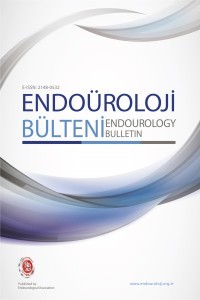Üreter Taşlarında Üreterorenoskopik Holmiyum: YAG Lazer Litotripsi Etkinliğini Etkileyen Faktörler
Üreter Taşı, Ho:YAG Lazer Litotripsi, Joule, Frekans
Factors Affecting the Efficacy of Ureterorenoscopic Holmium: YAG Laser Lithotripsy in Ureteral Stones
Ureteral Stone, Holmium:YAG Laser Lithotripsy, Joule, Frequency,
___
- 1. Thomas F, Córdoba A, López Silva M, et al. Litotricia neumática vs. litotricia láser Ho: YAG en el tratamiento de la litiasis ureteral (Pneumatic lithotripsy vs Holmium: YAG Laser lithotripsy for the treatment of ureteral stones.). Arch Esp Urol. 2021;74(8):768-773.
- 2. Patel AP, Knudsen BE. Optimizing use of the holmium:YAG laser for surgical management of urinary lithiasis. Curr Urol Rep. 2014;15(4):397. d https://doi.org/10,1007/s11934-014-0397-2 3. Kronenberg P, Traxer O. Update on lasers in urology 2014: current assessment on holmium:yttriumaluminum-garnet (Ho:YAG) laser lithotripter settings and laser fibers. World J Urol. 2015;33(4):463-469. https://doi.org/10,1007/s00345-014-1395-1
- 4. Elhilali MM, Badaan S, Ibrahim A, Andonian S. Use of the Moses Technology to Improve Holmium Laser Lithotripsy Outcomes: A Preclinical Study. J Endourol. 2017;31(6):598-604. https://doi.org/10,1089/ end.2017.0050
- 5. Knudsen BE. Laser Fibers for Holmium:YAG Lithotripsy: What Is Important and What Is New. Urol Clin North Am. 2019;46(2):185-191. https://doi.org/10,1016/j.ucl.2018.12.004
- 6. Fried NM, Irby PB. Advances in laser technology and fibre-optic delivery systems in lithotripsy. Nat Rev Urol. 2018;15(9):563-573. https://doi.org/10,1038/s41585-018-0035-8
- 7. Marks AJ, Teichman JM. Lasers in clinical urology: state of the art and new horizons. World J Urol. 2007;25(3):227-233. https://doi.org/10,1007/s00345-007-0163-x
- 8. Becker B, Gross AJ, Netsch C. Ho: YaG laser lithotripsy: recent innovations. Curr Opin Urol. 2019;29(2):103-107. https://doi.org/10,1097/MOU.0000000000000573
- 9. Ito H, Kawahara T, Terao H, et al. The most reliable preoperative assessment of renal stone burden as a predictor of stone-free status after flexible ureteroscopy with holmium laser lithotripsy: a single-center experience. Urology. 2012;80(3):524-528. https://doi.org/10,1016/j.urology.2012.04.001
- 10, Ulvik Ø, Æsøy MS, Juliebø-Jones P, Gjengstø P, Beisland C. Thulium Fibre Laser versus Holmium:YAG for Ureteroscopic Lithotripsy: Outcomes from a Prospective Randomised Clinical Trial. Eur Urol. 2022;82(1):73- 79. https://doi.org/10,1016/j.eururo.2022.02.027
- 11. Çelik S, Bozkurt O, Başara I, et al. Effects of Laser Probes and Computed Tomography Findings on Ureterorenoscopic Laser Lithotripsy Success Rate, Laser Time, Laser Energy Level and Operative Time for Distal Ureteral Stones Journal of Urological Surgery. 2019;6(3):201-206.
- 12. Molina WR, Marchini GS, Pompeo A, et al. Determinants of holmium:yttrium-aluminum-garnet laser time and energy during ureteroscopic laser lithotripsy. Urology. 2014;83(4):738-744. https://doi. org/10,1016/j.urology.2013.11.017
- 13. Ntasiotis P, Peteinaris A, Lattarulo M, et al. Holmium: Yttrium-aluminum-garnet laser lithotripsy: Is there a difference in ablation rates between short and long pulse duration?. Urol Ann. 2023;15(2):202-206. https://doi.org/10,4103/ua.ua_111_22
- 14. Aldoukhi AH, Black KM, Hall TL, Roberts WW, Ghani KR. Frequency Threshold for Ablation During Holmium Laser Lithotripsy: How High Can You Go?. J Endourol. 2020;34(10):1075-1081. https://doi. org/10,1089/end.2020,0149
- 15. Majdalany SE, Levin BA, Ghani KR. The Efficiency of Moses Technology Holmium Laser for Treating Renal Stones During Flexible Ureteroscopy: Relationship Between Stone Volume, Time, and Energy. J Endourol. 2021;35(S3):S14-S21. https://doi.org/10,1089/end.2021.0592
- 16. Ventimiglia E, Pauchard F, Gorgen ARH, et al. How do we assess the efficacy of Ho:YAG low-power laser lithotripsy for the treatment of upper tract urinary stones? Introducing the Joules/mm3and laser activity concepts. World J Urol. 2021;39(3):891-896. https://doi.org/10,1007/s00345-020-03241-9
- 17. Chen BH, Lin TF, Tsai CC, Chen M, Chiu AW. Comparison of Fragmentation and Dusting Modality Using Holmium YAG Laser during Ureteroscopy for the Treatment of Ureteral Stone: A Single-Center’s Experience. J Clin Med. 2022;11(14):4155. https://doi.org/10,3390/jcm11144155
- 18. Kuroda S, Ito H, Sakamaki K, et al. A new prediction model for operative time of flexible ureteroscopy with lithotripsy for the treatment of renal stones. PLoS One. 2018;13(2):e0192597. https://doi.org/10,1371/ journal.pone.0192597
- 19. Shrestha A, Corrales M, Adhikari M, et al.Comparison of low power and high power holmium YAG laser settings in flexible ureteroscopy. World J Urol.2022 Jul;40(7):1839-1844. https://doi.org/10,1007/ s00345-022-04040-0
- Yayın Aralığı: Yılda 3 Sayı
- Başlangıç: 2020
- Yayıncı: ENDOÜROLOJİ DERNEĞİ
Burhan COŞKUN, Halit Mustafa ACAR, Ahmet Eren TOTO, Gökhan OCAKOĞLU, Omer Faruk ASLAN, Onur KAYGİSİZ
Robot Yardımlı Böbrek Naklinde Bifazlı Sıvı Tedavisi’nin Etkinliği
Burhan COŞKUN, Sezin TÜRK KAYA, Yavuz Mert AYDIN, İsmail İFŞA, Seniha GÜNDÜZ, Hakan KILIÇARSLAN
Üreter Taşlarında Üreterorenoskopik Holmiyum: YAG Lazer Litotripsi Etkinliğini Etkileyen Faktörler
Genç Yaşta Görülen Transizyonel Hücreli Mesane Karsinomunda Genetik Yatkınlık Var Mıdır?
Selim TAŞ, Ali Erhan EREN, Mahmut Taha ÖLÇÜCÜ, Barış PAKSOY, Ekrem İSLAMOĞLU, Mehmet Salih BOĞA
Kompleks Üst Üriner Sistem Taş Tedavisinde Robotik Cerrahinin Rolü: Tek Merkez Deneyimi
Murat Can KİREMİT, Yakup KORDAN
Genital Siğillerin Erkeklerin Depresyonu ve Cinsel İşlevleri Üzerindeki Etkisi
